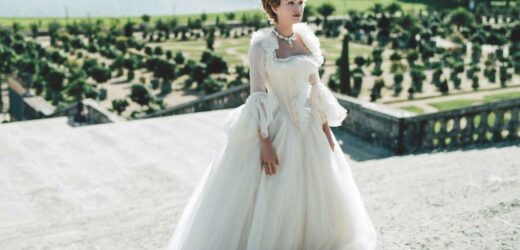On the outskirts of Paris, in a vast, industrial-looking studio in Bry-sur-Marne, the clocks have turned back to the 1770s. Opulent decor — gilded furniture, flower-adorned curtains and marble everywhere — fills the soundstage.
The atmosphere is studious on the set of “Marie-Antoinette,” a lavish French-produced costume drama created, co-written and executive produced by Deborah Davis. She’s delivering a feminist take on an infamous historical figure, best-known for apocryphally advising the starving masses to eat cake. We all know how that ended.
On screen, Marie-Antoinette hasn’t been treated better than she was at the guillotine, where she’s often depicted as a villain or a frivolous airhead.
“I found the fighter, and I loved being with her all the way through her battles,” says Davis, the Oscar-nominated writer of “The Favourite,” which focused on another queen, England’s Anne.
Emilia Schüle, a rising Russian-born German actor, plays Marie-Antoinette, an Austrian noble who married off to Louis-Auguste, the future king of France, while she was still a girl. She was sent there with one goal: Deliver an heir, preferably of the male persuasion. But nothing went as planned. Her husband refused to touch her for seven years and Marie-Antoinette’s rebellious ways wreaked havoc on the royal family. On screen and in real life, she alienated the French King Louis XV’s (James Purefoy) favorite, Madame du Barry (Gaia Weiss) and imploded the court’s peculiar customs.

“Marie-Antoinette arrived as a 14½-year-old like a stunned rabbit … and they all stared at her like, ‘Who is this revolting little Austrian archduchess?,” says Davis, who wrote the script with Louis Ironside, Chloe Moss and Avril E. Russell. “She didn’t stand a chance. But Marie-Antoinette comes from a very long line of extremely strong-willed, spirited women, and she took them on.”
Set to premiere later this month on Canal+ in France, the series is produced by Capa Drama, Banijay Studios France and Les Gens.
On set, Schüle is as unpredictable as Marie-Antoinette, to the extent that Pete Travis, who directed the first four episodes of the series (followed by Geoffrey Enthoven), says she was allowed to improvise and came in with “ideas about how her character might move or walk.”
Schüle admits that she and Marie-Antoinette “kind of melded together.”
“Her childishness and her playfulness really brought out that side in me to a crazy extent,” she says, noting that she also bonded with Purefoy, who plays her on-screen father-in-law.
“Louis XV welcomed her with open arms. He was a good guy until he tried to have sex with her,” says Schüle, hinting at one of the many traumas experienced by Marie-Antoinette during her early years at the French palace.
Previous portrayals of Marie-Antoinette “don’t explore the trauma and feeling of abandonment that this person must have felt,” says Schüle. Drawing a comparison with Princess Diana, she also describes Marie-Antoinette as a “rebel,” who was “modern, emancipated, and fought for equality and for her personal freedom.”

Davis’s feminist take is one aspect that appealed to Travis.
“History films are usually about men and in [this series] men make the world but it’s the women who have the strongest will, and that’s what makes it contemporary,” he says, teasing Marie-Antoinette and Madame du Barry’s relationship. “It’s a compelling, exciting, dangerous, even sexy relation between two very strong women.”
Additionally, the “tragic, delicate love story between Madame du Barry and Louis XV” is chronicled.
Nicknamed “the beloved,” at the end of his 58-year reign, Louis XV — accused of corruption and debauchery, and battling public opinion over his relationship with du Barry, a former prostitute he fell in love with and brought to court — lost much of his popularity. Purefoy, who embraced his role, says Louis XV was a “rule-breaker” living an “extremely eccentric life.”
“When I first read Deborah’s script, I thought, ‘Mad. They are all mad,’” says Purefoy. “But you have to imagine that every morning when he would wake up, 150 people would be in his bedroom.”
Observing the “perfectly shaped Versailles gardens” made him realize that Louis XV was most likely a “total control freak who was used to nothing being out of place.” When Marie-Antoinette comes along and “things start going out of place, there’s a sense of chaos and panic,” says the actor.
The French protocols, then called “etiquette,” were created by Louis XIV, the “Sun King” who was portrayed in the series “Versailles,” produced by the same team as “Marie-Antoinette”: Claude Chelli at Newen-owned Capa Drama, Banijay Studios France and Canal+’s Creation Originale label.
“In ‘Versailles,’ we showed how Louis XIV invented the etiquette, and in ‘Marie-Antoinette’ we show how the queen destroyed Versailles stone by stone and arranged to have her own life,” says Chelli, who produced the series with Stephanie Chartreux and Margaux Balsan. “It’s a very powerful story of emancipation.”
The series also introduces lesser-known real characters including Joseph Bologne de Saint-George, a Creole virtuoso violinist and conductor who was part of Marie-Antoinette’s entourage. “He was a very close friend of Marie-Antoinette and everybody was shocked because he was Black but she didn’t care,” says Chelli.
Aside from Bry-sur-Marne, the series shot on location at the Versailles Palace, the Chateau de Fontainbleau and the Chateau de Vaux le Vicomte. The crew consists of 780 people with top-notch artists such as costume designer Marie Fremont, costume artistic designer Madeline Fontaine and production designer Pierre Queffelean, assisted by Clovis Weil.
During his time on “Versailles,” Chelli learned the time-consuming process it takes for period dramas, since simply changing costumes and wigs could take nearly two hours. “Marie-Antoinette” took the challenge to a whole other level because she would “change wardrobe every 10 minutes.”
Many of the outfits in the show are made by hand, and several of those craftspeople also work at haute couture houses, including Chanel. Fremont’s team faced a shortage of period costumes in France because of the large number of dramas currently in production, so they searched for fabrics in Italy, England and Spain. The fabrics were then dyed to create a wide-ranging palette of colors and fake embroideries were applied by hand. “We decided on a color palette for each of them; it’s a saving strategy because we can mix and match outfits more easily and it creates a rich look and effect with less costume,” says Fremont.

The set of “Marie-Antoinette” took 2½ months to build, and interpretation was key. For one, the Versailles Palace was a dirty place in the 18th century. “Today, it’s very clean, painted in white with bright golds, but you have to think that back at that time, there were between 2,500 and 3,000 people who lived there constantly,” says Queffelean.
His team also built the tiny apartments in which Marie-Antoinette sought refuge to have more privacy, and reconstructed the corridors that Louis XVI built inside Versailles so that he could visit the queen without being seen by valets and guards.
Davis, who is also a historian, had been fascinated by Versailles for a long time when she was asked to pitch for this project.
“We always start at the end,” says Davis. “With her death, her torture and the cruelty and her trial where she was accused of incest, and for me, the joy was to be able to go back and pretend that never happened, because obviously from 1770 to 1780, there is no hint of a revolution.”
The second season, which Davis has already started writing, will cast a “more balanced” if not critical light on the French Revolution, which she views as a “misogynistic propaganda campaign against Marie-Antoinette.”
Centuries later, Marie-Antoinette’s icon status remains intact. Her diamonds were recently sold for “millions and millions of pounds” at an auction, Davis adds, “So, you can see what her value is today, let alone what her value was then.”
Read More About:
Source: Read Full Article


